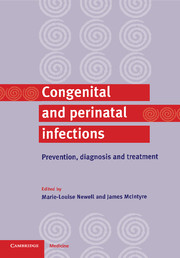Book contents
- Frontmatter
- Contents
- List of contributors
- Preface
- Part I General issues
- Part II Specific infections
- 5 Rubella infection in pregnancy
- 6 Perinatal Group B streptococcal infections
- 7 Mother-to-child transmission of cytomegalovirus
- 8 Varicella
- 9 Herpes simplex
- 10 Vertical transmission of hepatitis viruses
- 11 Papillomavirus infections as a perinatal problem: diagnosis, prevention and management
- 12 HIV-1 infection
- 13 Syphilis: prevention, diagnosis and management during pregnancy and infancy
- 14 The other sexually transmitted diseases
- 15 Toxoplasmosis
- 16 Neonatal sepsis
- Index
9 - Herpes simplex
Published online by Cambridge University Press: 06 July 2010
- Frontmatter
- Contents
- List of contributors
- Preface
- Part I General issues
- Part II Specific infections
- 5 Rubella infection in pregnancy
- 6 Perinatal Group B streptococcal infections
- 7 Mother-to-child transmission of cytomegalovirus
- 8 Varicella
- 9 Herpes simplex
- 10 Vertical transmission of hepatitis viruses
- 11 Papillomavirus infections as a perinatal problem: diagnosis, prevention and management
- 12 HIV-1 infection
- 13 Syphilis: prevention, diagnosis and management during pregnancy and infancy
- 14 The other sexually transmitted diseases
- 15 Toxoplasmosis
- 16 Neonatal sepsis
- Index
Summary
Introduction
Herpes simplex type 1 (HSV-1) and 2 (HSV-2) infections are common in pregnant women; the symptoms – if any – are generally mild. However, HSV infection during pregnancy can result in transmission of the virus to the neonate, sometimes with serious disease and severe sequelae in the child (Nahmias et al., 1983; Koskiniemi et al., 1989; Malm et al., 1991; Azazi et al., 1990; Whitley & Arvin, 1995). Prevention is difficult, as the majority of HSV infections during pregnancy are atypical or silent. Furthermore, in the neonate vague symptoms are often not recognizable as herpes simplex disease, and early treatment of an infected child is therefore usually not an option.
Transmission of herpes simplex virus infection to the neonate is rare, which makes identification of risk factors for transmission and evaluation of preventive strategies difficult. Although results from large multicentre studies and the use of improved virological diagnostic tools have contributed to knowledge, formulation of evidence-based recommendations for prevention and management is still not possible. Management of HSV infection in pregnant women and children may also be influenced by non-medical factors, such as anxiety.
The prevalence of herpes infection – genital and oral – varies by populations of pregnant women and so does the risk of neonatal herpes. Preventive strategies should be guided by the incidence of neonatal infections. For an estimate of the real rate of neonatal herpes, surveillance studies based on active search for neonatal infections have to be undertaken in collaboration between neonatologists and virological laboratories.
- Type
- Chapter
- Information
- Congenital and Perinatal InfectionsPrevention, Diagnosis and Treatment, pp. 145 - 163Publisher: Cambridge University PressPrint publication year: 2000



